Abstract
The metabolism of human prothrombin labeled with radioactive iodine was studied in seven normal subjects and four hemophilic patients. Results in the normal subjects were: plasma volume, 37.6±3.8 ml/kg; plasma prothrombin concentration, 303±40 U/ml (0.153±0.02 mg/ml); prothrombin half-life, 2.81±0.51 days; total plasma prothrombin pool, 5.72±0.62 mg/kg, representing 64.1±9.1% of total body prothrombin; fractional catabolic rate, 42.5±12.4% of the plasma pool per day; prothrombin synthesis rate, 2.43±0.76 mg/kg per day. Results in the hemophilic patients did not differ significantly from normal. Circulating products of prothrombin activation could not be demonstrated in normal individuals or hemophilic subjects. The data suggest that continuous physiologic activation of the blood coagulation mechanism plays only a small part, if any, in the normal catabolism of prothrombin.
Full text
PDF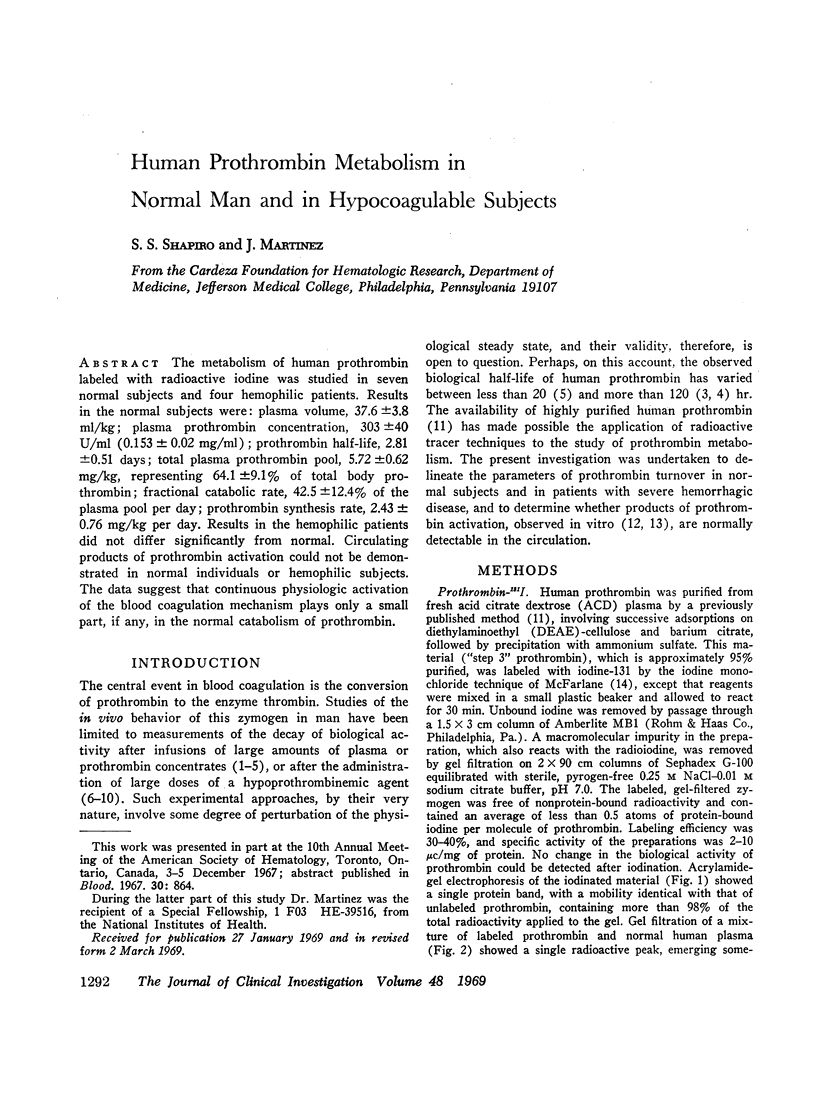

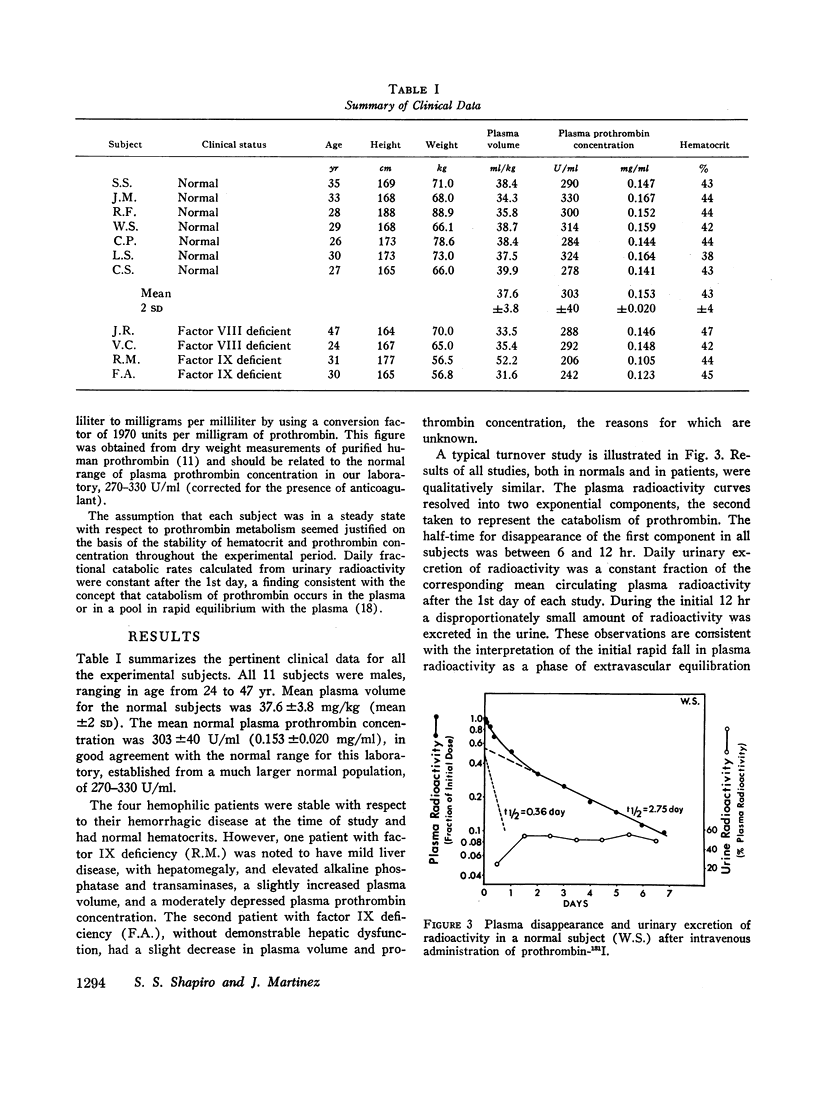
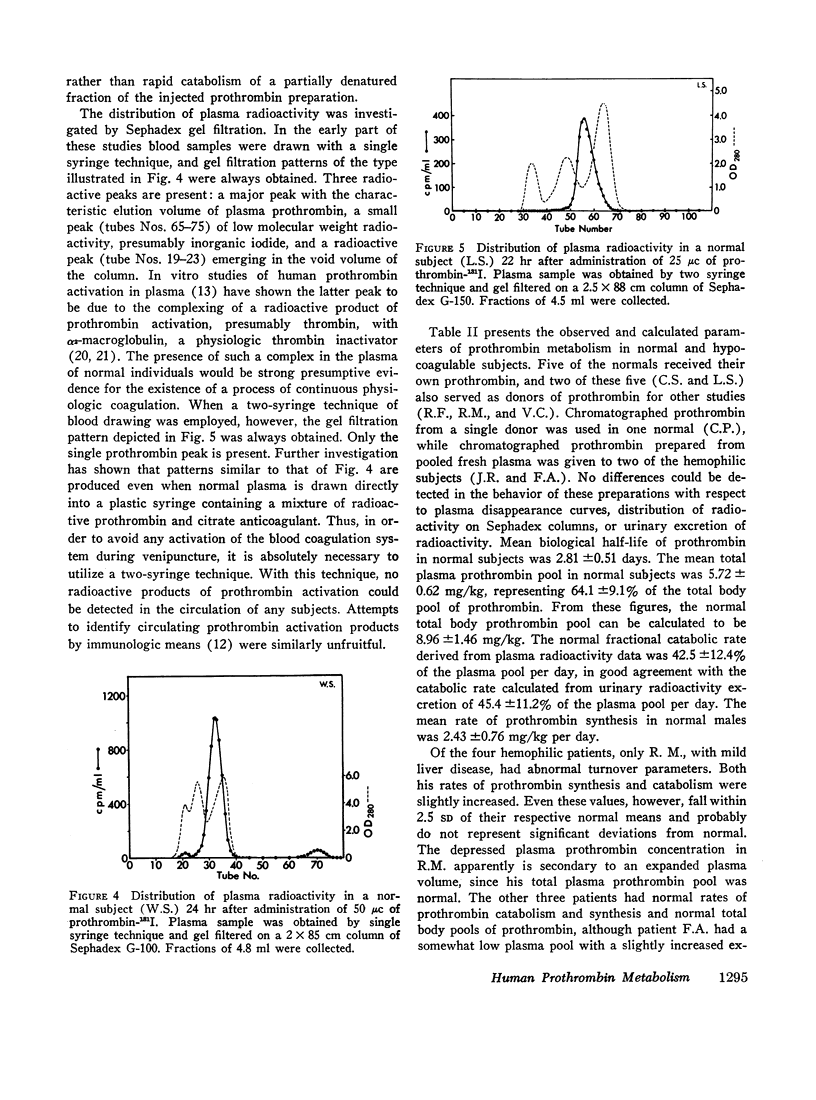
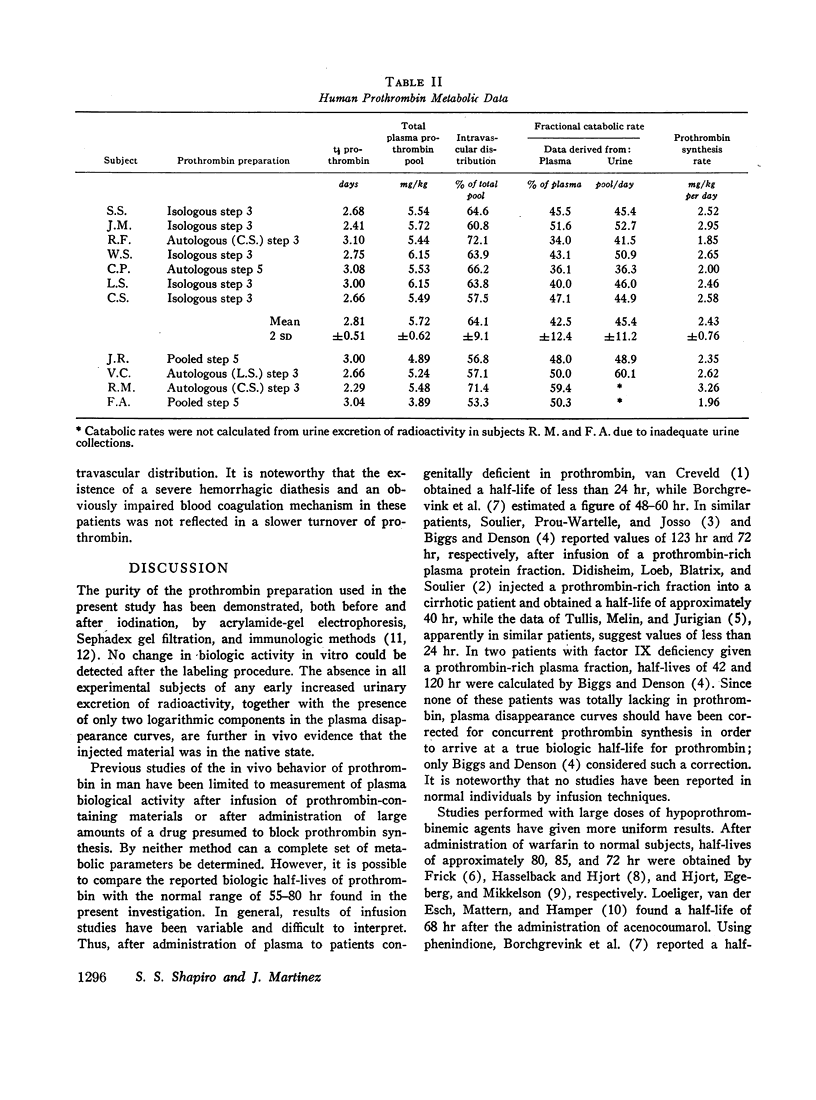
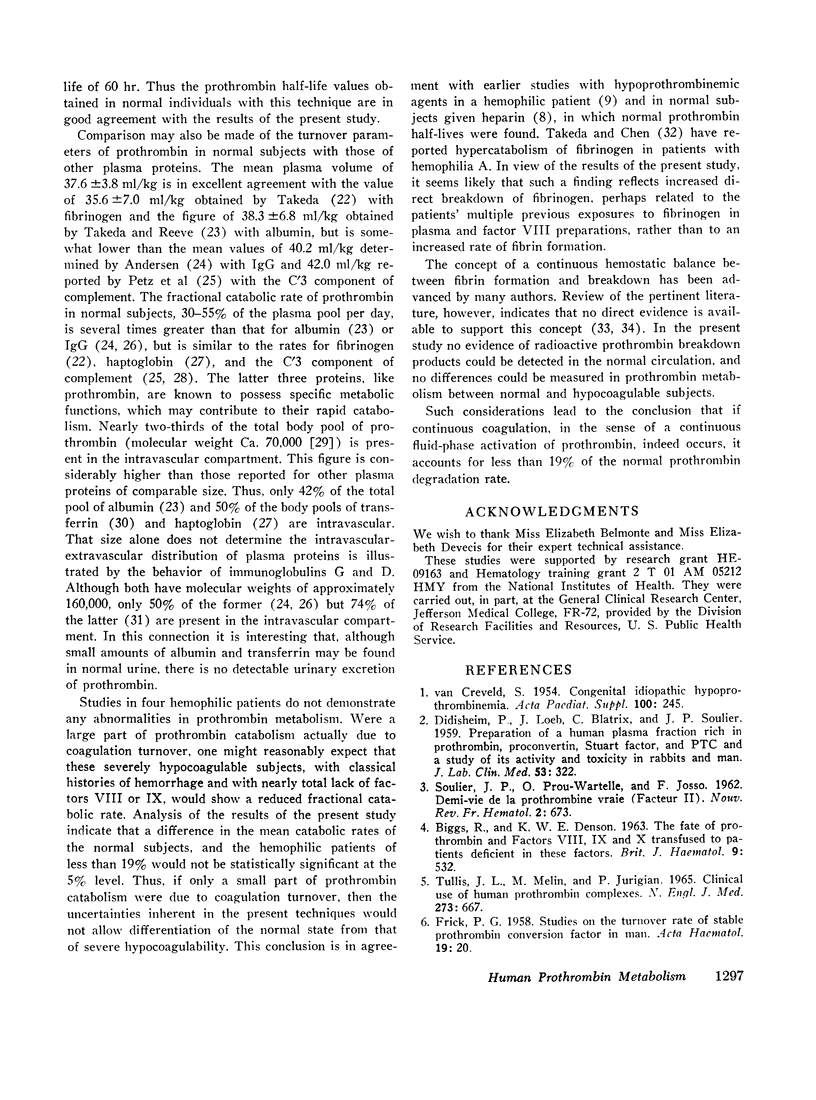
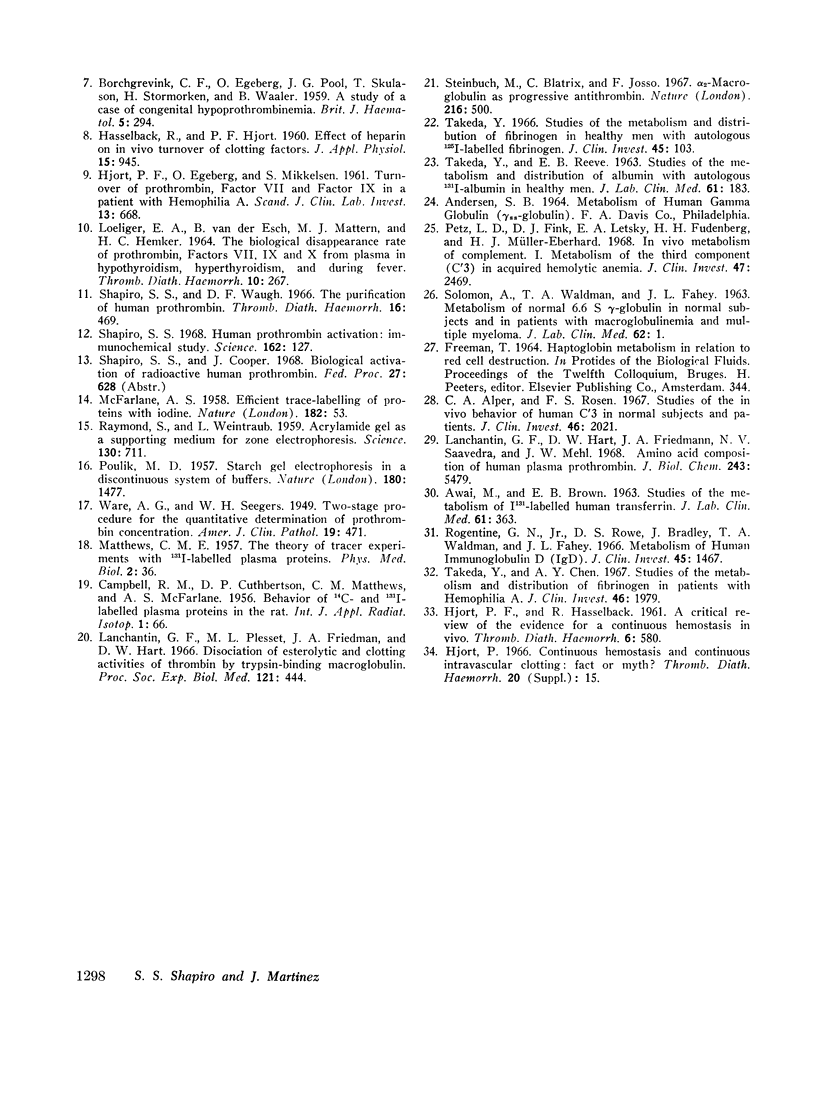
Images in this article
Selected References
These references are in PubMed. This may not be the complete list of references from this article.
- AWAI M., BROWN E. B. Studies of the metabolism of I-131-labeled human transferrin. J Lab Clin Med. 1963 Mar;61:363–396. [PubMed] [Google Scholar]
- Alper C. A., Rosen F. S. Alper CA, Rosen FS: Studies of the in vivo behavior of human C'3 in normal subjects and patients. J Clin Invest. 1967 Dec;46(12):2021–2034. doi: 10.1172/JCI105691. [DOI] [PMC free article] [PubMed] [Google Scholar]
- BIGGS R., DENSON K. W. THE FATE OF PROTHROMBIN AND FACTORS VIII, IX AND X TRANSFUSED TO PATIENTS DEFICIENT IN THESE FACTORS. Br J Haematol. 1963 Oct;9:532–547. doi: 10.1111/j.1365-2141.1963.tb05478.x. [DOI] [PubMed] [Google Scholar]
- BORCHGREVINK C. F., EGEBERG O., POOL J. G., SKULASON T., STORMORKEN H., WAALER B. A study of a case of congenital hypoprothrombinaemia. Br J Haematol. 1959 Jul;5:294–301. doi: 10.1111/j.1365-2141.1959.tb04037.x. [DOI] [PubMed] [Google Scholar]
- CAMPBELL R. M., CUTHBERTSON D. P., MATTHEWS C. M., MCFARLANE A. S. Behaviour of 14C- and 131I-labelled plasma proteins in the rat. Int J Appl Radiat Isot. 1956 Jul;1(1-2):66–84. doi: 10.1016/0020-708x(56)90020-5. [DOI] [PubMed] [Google Scholar]
- DIDISHEIM P., LOEB J., BLATRIX C., SOULIER J. P. Preparation of a human plasma fraction rich in prothrombin, proconvertin, Stuart factor, and PTC and a study of its activity and toxicity in rabbits and man. J Lab Clin Med. 1959 Feb;53(2):322–330. [PubMed] [Google Scholar]
- FRICK P. G. Studies on the turnover rate of stable prothrombin conversion factor in man. Acta Haematol. 1958 Jan;19(1):20–29. doi: 10.1159/000205410. [DOI] [PubMed] [Google Scholar]
- HASSELBACK R., HJORT P. F. Effect of heparin on in vivo turnover of clotting factor. J Appl Physiol. 1960 Sep;15:945–948. doi: 10.1152/jappl.1960.15.5.945. [DOI] [PubMed] [Google Scholar]
- HJORT P. F., EGEBERG O., MIKKELSEN S. Turnover of prothrombin, factor VII and factor IX in a patient with hemophilia A. Scand J Clin Lab Invest. 1961;13:668–672. doi: 10.3109/00365516109137342. [DOI] [PubMed] [Google Scholar]
- HJORT P. F., HASSELBACK R. A critical review of the evidence for a continous hemostasis in vivo. Thromb Diath Haemorrh. 1961 Dec 15;6:580–612. [PubMed] [Google Scholar]
- Hjort P. F. Continuous hemostasis and continuous intravascular clotting: fact or myth? Thromb Diath Haemorrh Suppl. 1966;20:15–38. [PubMed] [Google Scholar]
- LOELIGER E. A., VAN DER ESCH B., MATTERN M. J., HEMKER H. C. THE BIOLOGICAL DISAPPEARANCE RATE OF PROTHROMBIN, FACTORS VII, IX AND X FROM PLASMA IN HYPOTHYROIDISM, HYPERTHYROIDISM, AND DURING FEVER. Thromb Diath Haemorrh. 1964 Jan 1;10:267–277. [PubMed] [Google Scholar]
- Lanchantin G. F., Hart D. W., Friedmann J. A., Saavedra N. V., Mehl J. W. Amino acid composition of human plasma prothrombin. J Biol Chem. 1968 Oct 25;243(20):5479–5485. [PubMed] [Google Scholar]
- Lanchantin G. F., Plesset M. L., Friedmann J. A., Hart D. W. Dissociation of esterolytic and clotting activities of thrombin by trypsin-binding macroglobulin. Proc Soc Exp Biol Med. 1966 Feb;121(2):444–449. doi: 10.3181/00379727-121-30800. [DOI] [PubMed] [Google Scholar]
- MATTHEWS C. M. The theory of tracer experiments with 131I-labelled plasma proteins. Phys Med Biol. 1957 Jul;2(1):36–53. doi: 10.1088/0031-9155/2/1/305. [DOI] [PubMed] [Google Scholar]
- POULIK M. D. Starch gel electrophoresis in a discontinous system of buffers. Nature. 1957 Dec 28;180(4600):1477–1479. doi: 10.1038/1801477a0. [DOI] [PubMed] [Google Scholar]
- Petz L. D., Fink D. J., Letsky E. A., Fudenberg H. H., Müller-Eberhard J. In vivo metabolism of complement. I. Metabolism of the third component (C'3) in acquired hemolytic anemia. J Clin Invest. 1969 Nov;47(11):2469–2484. doi: 10.1172/JCI105929. [DOI] [PMC free article] [PubMed] [Google Scholar]
- RAYMOND S., WEINTRAUB L. Acrylamide gel as a supporting medium for zone electrophoresis. Science. 1959 Sep 18;130(3377):711–711. doi: 10.1126/science.130.3377.711. [DOI] [PubMed] [Google Scholar]
- Rogentine G. N., Jr, Rowe D. S., Bradley J., Waldmann T. A., Fahey J. L. Metabolism of human immunoglobulin D (IgD). J Clin Invest. 1966 Sep;45(9):1467–1478. doi: 10.1172/JCI105454. [DOI] [PMC free article] [PubMed] [Google Scholar]
- SOLOMON A., WALDMANN T. A., FAHEY J. L. Clinical and experimental metabolism of normal 6.6s gamma-globulin in normal subjects and in patients with macroglobulinemia and multiple myeloma. J Lab Clin Med. 1963 Jul;62:1–17. [PubMed] [Google Scholar]
- SOULIER J. P., PROU-WARTELLE O., JOSSO F. [Half-life of true prothrombin (factor II)]. Nouv Rev Fr Hematol. 1962 Sep-Oct;2:673–684. [PubMed] [Google Scholar]
- Shapiro S. S. Human prothrombin activation. Science. 1968 Oct 4;162(3849):127–129. doi: 10.1126/science.162.3849.127. [DOI] [PubMed] [Google Scholar]
- Steinbuch M., Blatrix C., Josso F. Alpha-2-macroglobulin as progressive antithrombin. Nature. 1967 Nov 4;216(5114):500–501. doi: 10.1038/216500a0. [DOI] [PubMed] [Google Scholar]
- TAKEDA Y., REEVE E. B. Studies of the metabolism and distribution of albumin with autologous I131-albumin in healthy men. J Lab Clin Med. 1963 Feb;61:183–202. [PubMed] [Google Scholar]
- Takeda Y., Chen A. Y. Studies of the metabolism and distribution of fibrinogen in patients with hemophilia A. J Clin Invest. 1967 Dec;46(12):1979–1985. doi: 10.1172/JCI105687. [DOI] [PMC free article] [PubMed] [Google Scholar]
- Takeda Y. Studies of the metabolism and distribution of fibrinogen in healthy men with autologous 125-I-labeled fibrinogen. J Clin Invest. 1966 Jan;45(1):103–111. doi: 10.1172/JCI105314. [DOI] [PMC free article] [PubMed] [Google Scholar]
- Tullis J. L., Melin M., Jurigian P. Clinical use of human prothrombin complexes. N Engl J Med. 1965 Sep 23;273(13):667–674. doi: 10.1056/NEJM196509232731301. [DOI] [PubMed] [Google Scholar]
- VAN CREVELD S. Congenital idiopathic hypoprothrombinemia. Acta Paediatr Suppl. 1954;43(100):245–255. doi: 10.1111/j.1651-2227.1954.tb15475.x. [DOI] [PubMed] [Google Scholar]



